
Understanding lung cancer and its symptoms
Lung cancer is the second most common cancer in the country, the first being prostate cancer in men and breast cancer in women. The American Cancer Society, in its annual forecast, has estimated that at least 228,150 new cases of lung cancer and 142,670 deaths are likely to happen in 2019. Lung cancer if detected early is completely curable. Even though smoking is considered to be the main cause of lung cancer, there are other factors which are equally harmful.
Primary and secondary cancer are the two types of lung cancer. Cancer that starts in the lungs is primary cancer and cancer which starts in other parts of the body and spreads to the lungs is secondary cancer. The first type is the most common type of lung cancer with four out of five patients affected by it. There are many types of primary cancer based on the types of cells that are affected.
Non-small lung cancer (NSCLC): Four out of five cancers are of this type. This is most common among smokers and those who inhale that smoke regularly. NSCLC can be further classified as:
- Adenocarcinoma: Starting in the cells of the outer part of the lungs, i.e., in the air sacs where mucus is produced. The most common type of NSCLC, this affects people under 45 and affects both smokers and non-smokers. This spreads slowly.
- Squamous cell carcinoma: This starts in the inner lining of the airways in the lungs. One in four NSCLC cancers is of this type.
- Large cell carcinoma: It often occurs in the outer region of the lungs and spreads faster than other types of NSCLC.
Small cell lung cancer (SCLC): This starts in the middle of the lungs and spreads faster than NSCLC.
Mesothelioma: There are two types of mesothelioma which are caused by exposure to asbestos.
- Pleural Mesothelioma: This affects the pleura, which is the outer covering of the lungs.
- Peritoneal Mesothelioma: This affects the lining of the abdomen.
Other tumors: There are chances of tumors forming in the space between the lungs and the chest wall called mediastinum. Tumors, though not common, can also form in the bones, muscles, and cartilage.
Lung cancer occurs mostly in older people and the average age of detection is 65. If detected in the early stages, it is completely curable in most cases. It is estimated that more than 400,000 people who had lung cancer at some stage in their life have been cured and are living a healthy life today. Symptoms to watch out for are:
- A persistent cough or change in cough pattern for anyone with previous lung disease.
- Breathlessness
- Back pain
- Recurrent incidences of pneumonia and bronchitis
- Bloody cough or splitting blood during a bout of cough
- Pain in the chest
Other symptoms are a loss of weight, change in voice, joint pain, wheezing. None of these are direct symptoms of lung cancer and normally comes to light much later, when the cancer is at an advanced stage.


